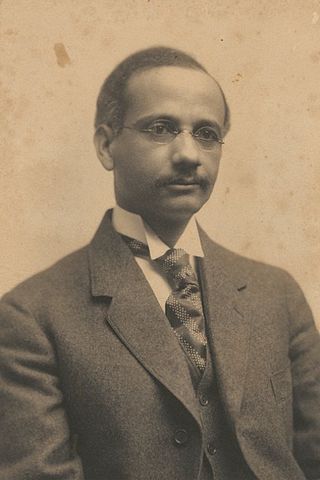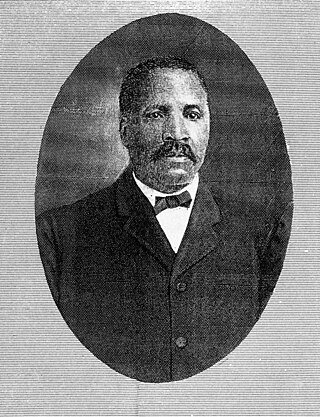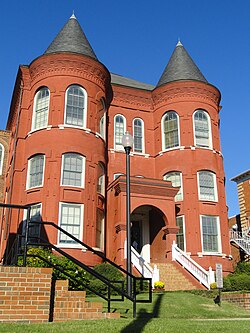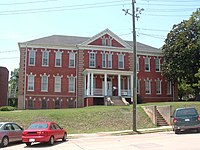
Raleigh is the capital city of the state of North Carolina and the seat of Wake County in the United States. It is the second-most populous city in North Carolina, after Charlotte. Raleigh is the tenth-most populous city in the Southeast, the 41st-most populous city in the U.S., and the largest city of the Research Triangle metro area. Raleigh is known as the "City of Oaks" for its many oak trees, which line the streets in the heart of the city. The city covers a land area of 147.6 sq mi (382 km2). The U.S. Census Bureau counted the city's population as 467,665 in the 2020 census. It is one of the fastest-growing cities in the United States. The city of Raleigh is named after Sir Walter Raleigh, who established the now-lost Roanoke Colony in present-day Dare County.
The Research Triangle, or simply The Triangle, are both common nicknames for a metropolitan area in the Piedmont region of the U.S. state of North Carolina. Anchored by the cities of Raleigh, Durham and Chapel Hill, the region is home to three major research universities: North Carolina State University, Duke University, and the University of North Carolina at Chapel Hill, respectively. The "Triangle" name originated in the 1950s with the creation of Research Triangle Park located between the three anchor cities, which is the largest research park in the United States and home to numerous high tech companies.
Shaw University is a private Baptist historically black university in Raleigh, North Carolina. It is affiliated with the American Baptist Churches USA. Founded on December 1, 1865, Shaw University is the oldest HBCU to begin offering courses in the Southern United States. The school had its origin in the formation of a theological class of freedmen in the Guion Hotel. The following year it moved to a large wooden building, at the corner of Blount and Cabarrus Streets in Raleigh, where it continued as the Raleigh Institute until 1870. In 1870, the school moved to its current location on the former property of Confederate General Barringer and changed its name to the Shaw Collegiate Institute, in honor of Elijah Shaw. In 1875, the school was officially chartered with the State of North Carolina as Shaw University.

Knoxville College is a historically black liberal arts college in Knoxville, Tennessee, United States, which was founded in 1875 by the United Presbyterian Church of North America. It is a United Negro College Fund member school.

Solomon Carter Fuller was a pioneering Liberian neurologist, psychiatrist, pathologist, and professor. Born in Monrovia, Liberia, he completed his college education and medical degree (MD) in the United States. He studied psychiatry in Munich, Germany, then returned to the United States, where he worked for much of his career at Westborough State Hospital in Westborough, Massachusetts.

John A. Lankford, American architect. He was the first professionally licensed African American architect in Virginia in 1922 and in the District of Columbia in 1924. He has been regarded as the "dean of black architecture".

The Pope House Museum, built in 1901, is a restored home once owned by Dr. Manassa Thomas Pope, a prominent African-American citizen of Raleigh, North Carolina. The Pope House is listed on the National Register of Historic Places in 1999, It was an official project of the Save America’s Treasures Program and the city of Raleigh took over management of it, offering tours for the first time in 2012.

Estey Hall is a historic building on the campus of Shaw University in Raleigh, North Carolina. It was the first building constructed for the higher education of African-American women in the United States. Built in 1873, Estey Hall is the oldest surviving building at Shaw, which is the oldest historically black college in the South and was the second institution of higher learning established for freedmen after the Civil War. The building, originally known as "Estey Seminary," was named in honor of Jacob Estey, the largest donor to the construction project. Estey Hall, located in the East Raleigh-South Park Historic District, was listed on the National Register of Historic Places in 1973 and is a Raleigh Historic Landmark.

The East Raleigh–South Park Historic District is the largest African-American neighborhood in Raleigh, North Carolina. The district, located south and east of downtown Raleigh, covers approximately 30 blocks and contains portions of the Smith–Haywood and St. Petersburg neighborhoods. Most homes in these neighborhoods were built between 1900 and 1940, with one-fifth dating back to the 19th century. Historic buildings in the district include Estey Hall and Leonard Hall, both located on the campus of Shaw University. The district was listed on the National Register of Historic Places in October 1990.
Duke University Hospital is a 957-bed acute care facility and an academic tertiary care facility located in Durham, North Carolina. Established in 1930, it is the flagship teaching hospital for the Duke University Health System, a network of physicians and hospitals serving Durham County and Wake County, North Carolina, and surrounding areas, as well as one of three Level I referral centers for the Research Triangle of North Carolina. It is affiliated with the Duke University School of Medicine.

Henry Martin Tupper was an American Baptist minister who founded Shaw University in Raleigh, North Carolina. Beginning with bible and literacy classes in December 1865, it was the second university established for African Americans following the end of the civil war, and the second oldest historically black college and university (HBCU) in the Southern United States, as well as one of the oldest co-educational universities in the country. When the institute moved into a new building in 1871, it was renamed as Shaw Collegiate Institute in honor of a major donor. Tupper served as the University's first president from its founding until his death in 1893.

William Fletcher Penn was a prominent African-American medical doctor in Atlanta, Georgia and a founding member of the Atlanta Chapter of the National Association for the Advancement of Colored People (NAACP).

Lincoln Hospital was a medical facility located in Durham, North Carolina founded to serve the African Americans of Durham County and surrounding areas. With original hospital construction financed by the Duke family, Lincoln served as the primary African American hospital in Durham from its opening in 1901 until 1976, when it closed and transferred its inpatient services to Durham County General Hospital.

Clinton Caldwell Boone was an African-American Baptist minister, physician, dentist, and medical missionary who served in the Congo Free State and Liberia. The son of Rev. Lemuel Washington Boone and Charlotte (Chavis) Boone of Hertford County, North Carolina, he played an important role in Africa as a missionary for the Lott Carey Foreign Mission Convention and the American Baptist Missionary Union, now American Baptist International Ministries.

Lawson Andrew Scruggs (1857–1914) was a physician in North Carolina who was active in politics and civil rights. He was African American. In 1893, he published a volume of biographies of African-American Women, Women of Distinction.

St. Agnes Hospital was a private hospital in Raleigh, North Carolina, United States. Open from 1896 to 1961, it served the city's black residents. The hospital and an associated nursing school were founded after Aaron Burris Hunter and Sarah Hunter, instructors at St. Augustine's College, became concerned about the limited options local black residents had for medical care. Originally operating out of a former home on St, Augustine's campus, the hospital moved to a new four-story stone building in 1909. Largely reliant on philanthropic contributions, the hospital struggled to maintain adequate funding throughout its existence and served a large number of charity patients. Accredited by the American Medical Association and the American College of Surgeons, dozens of physicians and approximately 500 nurses were trained at the hospital. By the mid-1950s, the hospital was struggling to fund advancements needed to keep up with improving medical care and stricter accreditation standards. The hospital building was condemned in 1955 and the institution closed in April 1961 after Wake County opened a public hospital to treat both black and white patients. The main hospital building fell into ruins, and in 1979 it was declared a local historic landmark by the city of Raleigh.

Isaac David Burell was an physician and pharmacist in Roanoke, Virginia. He was African-American.

Willie Virginia Otey Kay was an African-American dressmaker. She was known for making wedding dresses and debutante gowns for almost sixty years, becoming one of the most sought-after designers for women's formalwear in North Carolina. Kay began her dressmaking business during the Jim Crow Era, catering to both black and white clientele. She dressed young women being presented to society at the all-white North Carolina Debutante Ball and the all-black Alpha Kappa Alpha Debutante Ball, often attending the balls as a guest. In 1935, McCall's did a story on Kay and her work. In 1951, one of Kay's debutante gowns was featured on the cover of Life. Her work was also featured in The News & Observer and, in 2016, the North Carolina Museum of History presented an exhibit on her life. Kay was the mother of civil rights activist June Kay Campbell and the grandmother of politicians Ralph Campbell Jr. and Bill Campbell.




















